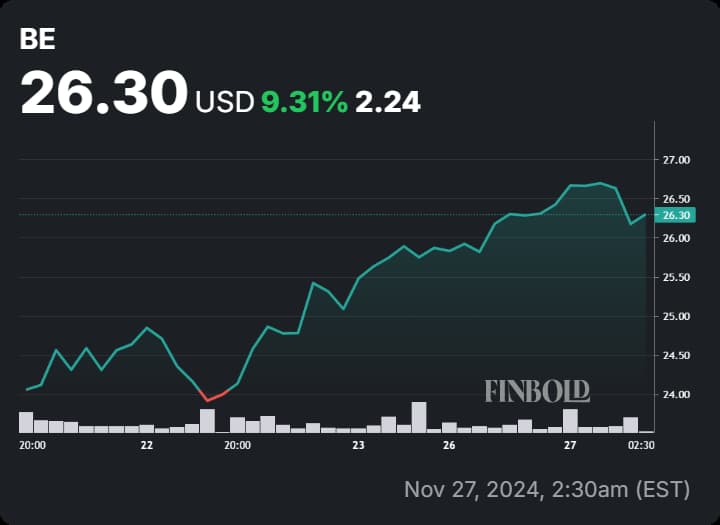Bloom Energy Corporation (NYSE: BE) has seized the spotlight after announcing a landmark agreement with American Electric Power (NASDAQ: AEP) to supply up to one gigawatt (GW) of solid oxide fuel cells.
The deal includes an initial order of 100 megawatts (MW) to power AEP’s artificial intelligence (AI) data centers, marking the largest commercial fuel cell procurement globally.
Expected to expand further in 2025, the agreement highlights Bloom Energy’s pivotal role in addressing the energy demands of AI-driven data centers—a sector experiencing explosive growth.
The market response to the AEP deal has been swift and dramatic. Shares of Bloom Energy surged nearly 59% on November 15, reaching an intraday high of $22.50, their highest level in over 20 months, as reported by Finbold.

The momentum continued as the stock recently hit a 52-week high. As of now, it is trading at $26.30, reflecting a robust 13% weekly gain and an extraordinary 101% increase over the past year.
Analyst reactions: Optimism with diverging views
Bloom Energy’s breakthrough deal has drawn attention from analysts, eliciting a range of reactions.
UBS analyst Manav Gupta raised his price target on Bloom Energy to $33 from $21 while maintaining a “Buy” rating, citing the agreement as a potential catalyst for future contracts with utilities. He noted surging demand for electricity-intensive applications like AI and data centers as a driving force behind Bloom’s growth.
Similarly, Piper Sandler analyst Kashy Harrison raised Bloom Energy’s price target to $30 from $20, maintaining an “Overweight” rating. The analyst highlighted Bloom’s growing customer base and reduced risk from changes in the Inflation Reduction Act as key positives.
Once the renewable energy market stabilizes, Harrison sees Bloom, a leader in utility-scale equipment, as well-positioned to capitalize on equity gains.
Caution amid optimism
In contrast, Jefferies analyst Dushyant Ailani took a more cautious approach, raising the price target to $22 from $12 but maintaining a “Hold” rating. Ailani acknowledged the AEP deal as a positive milestone while emphasizing the critical role of investment tax credits in securing the agreement.
He expects Bloom to finalize similar deals by year-end and sees strong growth potential for 2025. However, concerns over the stock’s valuation tempered his optimism.
Meanwhile, HSBC downgraded Bloom Energy to “Hold” from “Buy,” despite raising its price target to $24.50 from $17.20. The firm cited near-term valuation concerns following the stock’s remarkable 79% rally over three sessions after the AEP announcement. HSBC also noted that while Bloom has sufficient manufacturing capacity, it may need to expand its Fremont facility to meet future demand.
Overall, analysts recognize Bloom’s strong growth trajectory, though differing views on valuation and market conditions create a split in sentiment.
Opportunities and risks ahead
Bloom Energy is actively expanding its operations to capitalize on rising demand, with notable advancements such as an 80-megawatt project in South Korea and increased manufacturing capacity in Fremont.
These strategic moves enhance its ability to fulfill large-scale contracts like the transformative AEP deal, which could potentially generate over $7 billion in revenue based on historical trends.
Bloom Energy’s financial performance continues to strengthen, with gross margins reaching nearly 24% in Q3 2024 as the company makes steady progress toward operating and net profitability.
For 2024, the company has projected revenues between $1.4 billion and $1.6 billion, signaling strong confidence in its ability to sustain and accelerate its growth trajectory.
However, challenges remain. Valuation concerns and scaling production pose significant hurdles, as evidenced by bearish sentiment in options trading.
The Put/Call Ratio stands at 1.98, indicating a strong bearish bias, while at-the-money implied volatility (ATM IV) has risen by nearly 3 points, signaling heightened market anticipation of volatility.
Investors should closely monitor Bloom’s upcoming earnings report, scheduled for February 13, which will serve as a crucial indicator of whether the company can maintain its momentum and meet its ambitious growth targets.
Featured image via Shutterstock








